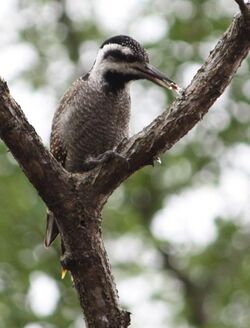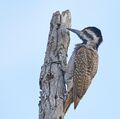Biology:Chloropicus
From HandWiki
Short description: Genus of birds
| Chloropicus | |
|---|---|

| |
| Bearded woodpecker Chloropicus namaquus | |
| Scientific classification | |
| Domain: | Eukaryota |
| Kingdom: | Animalia |
| Phylum: | Chordata |
| Class: | Aves |
| Order: | Piciformes |
| Family: | Picidae |
| Tribe: | Melanerpini |
| Genus: | Chloropicus Malherbe, 1845 |
| Type species | |
| Picus (Chloropicus) pyrrhogaster[1] Malherbe, 1845
| |
| Species | |
|
3, see text | |
Chloropicus is a genus of birds in the woodpecker family Picidae that are native to Sub-Saharan Africa.
Taxonomy
The genus was introduced by the French ornithologist Alfred Malherbe in 1845 with the fire-bellied woodpecker (Chloropicus pyrrhogaster) as the type species.[2] The word Chloropicus is from the Greek khlōros meaning green and pikos meaning woodpecker.[3] Molecular genetic studies have shown that the genus Chloropicus is sister to the genus Dendropicos.[4][5] Species in this genus were previously sometimes assigned to Dendropicos.[6][7]
The genus contains the three species:[7]
| Image | Scientific name | Common Name | Distribution |
|---|---|---|---|
 |
Chloropicus namaquus | Bearded woodpecker | Angola, Botswana, Central African Republic, Chad, Democratic Republic of the Congo, Ethiopia, Kenya, Malawi, Mozambique, Namibia, Rwanda, Somalia, South Africa, Sudan, Swaziland, Tanzania, Uganda, Zambia, and Zimbabwe |
 |
Chloropicus xantholophus | Yellow-crested woodpecker | Angola, Cameroon, Central African Republic, Republic of the Congo, Democratic Republic of the Congo, Gabon, Kenya, Nigeria, South Sudan, Tanzania and Uganda. |
 |
Chloropicus pyrrhogaster | Fire-bellied woodpecker | Benin, Ivory Coast, Ghana, Guinea, Liberia, Mali, Nigeria, Sierra Leone, Togo and western Cameroon |
References
- ↑ "Picidae". The Trust for Avian Systematics. https://www.aviansystematics.org/4th-edition-checklist?viewfamilies=96.
- ↑ Malherbe, Alfred (1845). "Description de dix espéces nouvelles du genre Picus, Linné" (in fr, la). Revue Zoologique par la Société Cuvierienne 8: 399. https://www.biodiversitylibrary.org/page/2327623.
- ↑ Jobling, James A. (2010). The Helm Dictionary of Scientific Bird Names. London: Christopher Helm. p. 103. ISBN 978-1-4081-2501-4. https://archive.org/details/Helm_Dictionary_of_Scientific_Bird_Names_by_James_A._Jobling.
- ↑ Shakya, S.B.; Fuchs, J.; Pons, J.-M.; Sheldon, F.H. (2017). "Tapping the woodpecker tree for evolutionary insight". Molecular Phylogenetics and Evolution 116: 182–191. doi:10.1016/j.ympev.2017.09.005. PMID 28890006. https://www.researchgate.net/publication/319596154.
- ↑ Fuchs, J.; Pons, J.-M.; Bowie, R.C.K. (2017). "Biogeography and diversification dynamics of the African woodpeckers". Molecular Phylogenetics and Evolution 108: 88–100. doi:10.1016/j.ympev.2017.01.007. PMID 28089840.
- ↑ Fuchs, J.; Pons, J.M. (2015). "A new classification of the pied woodpeckers assemblage (Dendropicini, Picidae) based on a comprehensive multi-locus phylogeny". Molecular Phylogenetics and Evolution 88: 28–37. doi:10.1016/j.ympev.2015.03.016. PMID 25818851.
- ↑ 7.0 7.1 Gill, Frank; Donsker, David, eds. "Woodpeckers". World Bird List Version 6.2. International Ornithologists' Union. http://www.worldbirdnames.org/bow/woodpeckers/.
Wikidata ☰ Q16536157 entry
 |

